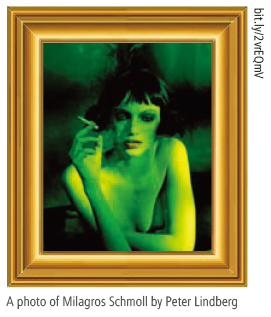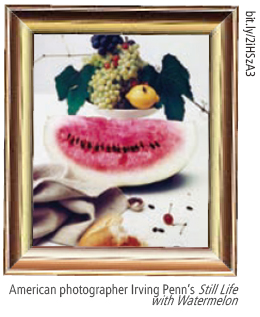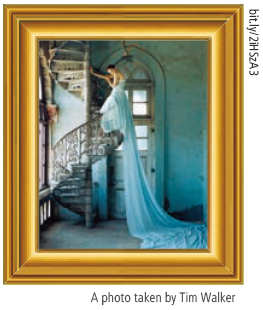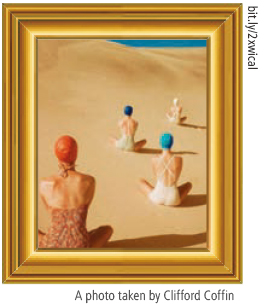Connection makes a lot of things special. The ones that could not shine before can have a new value by connecting them in a different point of view. Here in Hangaram Art Museum of the Seoul Arts Center, an exhibition was held with a unique theme; a connection between the famous paintings and photographs from Vogue Magazine.
Vogue Magazine started to be published in 1892 with topics including fashion, life, and design. Since it has shown everything about fashion in a most contemporary way following each country's tendencies, its reputation is increasing every year. In this exhibition, you can find masterpieces of famous international photographers, including Irving Penn, Paolo Roversi, and Peter Lindbergh, which are influenced by old master drawings. Some of them came directly from Vogue archives, the archive of 125-year history. Now, let us introduce six sections of this exhibition.

Section 1: Portrait
Right after people walked into the entrance, soft but little dark illuminations surrounded them. The entirely different atmosphere from the outside world made the viewers feel comfortable and helped them concentrate on the arts. After a short hallway with a video clip, there was a portrait section. Since the works here were not drawings but photos, naturalness was found from most of the works. In a portrait of Milagros Schmoll, people could find even dark circle and wrinkles on her forehead. According to the docent, Peter Lindberg, a person who took this photo, was a photographer who pursued taking photos without artificial feelings. Since he thought the relationship between models and photographers is an important element for the naturalness of the atmosphere, he tried to have a good relationship with his models. It seemed works reflect photographer's thoughts a lot.

Section 2: Still Life
The second section was still life. Since famous American photographer Irving Penn's Still Life with Watermelon, the most expensive work in this exhibition, was located here, a lot of people came to see it. Also, photos that make viewers recognize the original work attracted more attention, like the ones inspired by Vincent van Gogh, Paul Cezanne, and Michelangelo da Caravaggio. At the end of the wall, a monitor was showing us the process of apples decaying. As time goes on, it became hard to recognize the original shape of the apples, which was fresh and had vivid colors at first. Everything changed in this video clip except a pen in front of the basket. It seemed this work matches well with this section, Still Life, which tried to express the beauty of transience in everything.

Section 3: Rococo
Since showy color and delicate ornamentation are the features of Rococo, the first one jumped into the eyes in this section was a beautiful color. Most of the models were women, wearing a long, colorful dress in pastel tone. Among works in this section, the one that had the highest popularity was Tim Walker's work. At first glance, it seemed it did not require that much effort to take a picture of it. However, according to the docent’s explanation, 12 staffs and 15 full-sized carriers were mobilized to the scene to take this photo. The end part of the dress trailing on the floor reminded people of calm waves of the sea.

Section 4: Landscape
The fourth section was landscape, a genre that Koreans love the most. In this section, photographers reinterpreted masterpieces drawn by Gustav Klimt and Sandro Botticelli in their own way. Since photos taken in the garden were exhibited on the artificial lawn, spectators could vividly feel the atmosphere of the photos. The work that appeared on ticket, pamphlet, and the outer wall of Seoul Art Center was also exhibited on this lawn part of the hall. It was “Ophelia”, taken and made by Mert Alas and Marcus Piggott (M&M). Whereas some photographers pursued naturalness in their works, M&M tried to express ideals that cannot be found in reality. Since it looked like a scene that can never be found in reality, we can say their thought is well expressed in this work considering the fact that they even used photoshop program in editing the work.

Section 5: From the Avant-garde to Pop Art
The fifth section included everything about 20th century, which was a period of turbulence in art history. There were works inspired by Matisse and Jackson Pollock. A lot of works were impressive, including the work by Clifford Coffin who tried to express a dreamlike image by using surrealism. Even at first glance, spectators could feel something strange because models in this photo were wearing swimming suits in a desert. After a while, a sense of uneasiness came to us because none of the models were showing us their faces. According to an explanation, not showing a face was a technique that surrealists usually use to extract anxiety. In this section, spectators were able to see not only the works of artists but also Vogue Paris through displayed iPads. There were a goodly number of interested spectators.
Section 6: Vogue Korea Special Section
Since this section was apart from other sections, spectators had to come out of the exhibition hall to see it. About 20 works that were selected carefully from the magazine Vogue Korea were exhibited. This part was not that long and not that impressing.
The title of this exhibition, Vogue Like a Painting, means to see works that were put on display in this exhibition, and that were in Vogue Magazine like a painting. Now, how do you feel about this uncommon connection? Do you like a Vogue? Do you like a painting?
An Yoon-hee
dbsgml2017@uos.ac.kr

